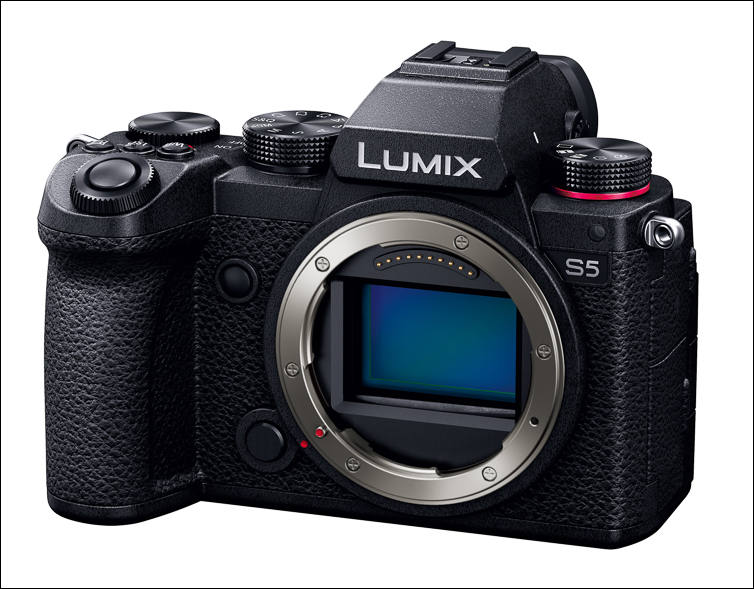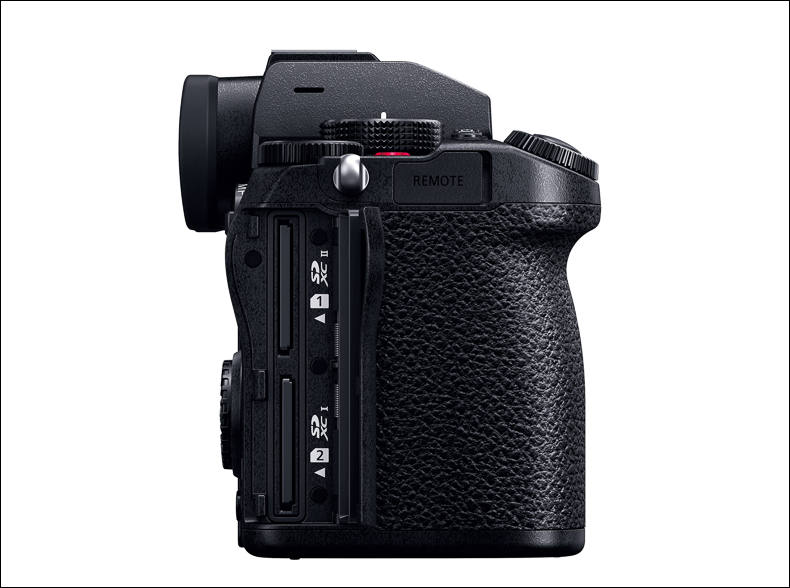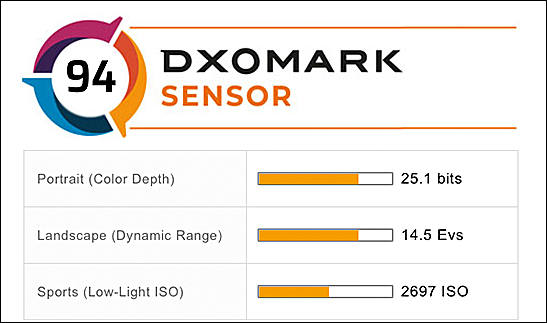
-

Specs
- 24.2Mp 35mm FF CMOS sensor
- DR - 14+ stops (in V-Log)
- Video formats
- MOV: H.264/MPEG-4 AVC, H.265/HEVC (Audio format: LPCM (2ch 48kHz/16-bit))
- MP4: H.264/MPEG-4 AVC, H.265/HEVC (Audio format: AAC (2ch))
- Recording modes, MOV
- FF, 4K, 3840×2160
- 29.97p, 150Mbps (4:2:2 10-bit LongGOP) / 100Mbps (4:2:0 8-bit LongGOP) (H.264/MPEG-4 AVC, LPCM)
- 23.98p, 150Mbps (4:2:2 10-bit LongGOP) / 100Mbps (4:2:0 8-bit LongGOP) (H.264/MPEG-4 AVC, LPCM
- 25.00p, 150Mbps (4:2:2 10-bit LongGOP) / 100Mbps (4:2:0 8-bit LongGOP) (H.264/MPEG-4 AVC, LPCM)
- FF, FHD, 1920×1080
- 59.94p, 100Mbps (4:2:2 10-bit LongGOP) / 100Mbps (4:2:0 8-bit LongGOP) (H.264/MPEG-4 AVC, LPCM)
- 29.97p, 100Mbps (4:2:2 10-bit LongGOP)/ 100Mbps (4:2:0 8-bit LongGOP) (H.264/MPEG-4 AVC, LPCM)
- 23.98p, 100Mbps (4:2:2 10-bit LongGOP) / 100Mbps (4:2:0 8-bit LongGOP) (H.264/MPEG-4 AVC, LPCM)
- 50.00p, 100Mbps (4:2:2 10-bit LongGOP) / 100Mbps (4:2:0 8-bit LongGOP) (H.264/MPEG-4 AVC, LPCM)
- 25.00p, 100Mbps (4:2:2 10-bit LongGOP) / 100Mbps (4:2:0 8-bit LongGOP) (H.264/MPEG-4 AVC, LPCM)
- APS-C / Pixel by Pixel, 3840×2160
- 59.94p, 200Mbps (4:2:0 10-bit LongGOP) (H.265/HEVC, LPCM)
- 59.94p, 150Mbps (4:2:0 8-bit LongGOP) (H.264/MPEG-4 AVC, LPCM)
- 29.97p, 150Mbps (4:2:2 10-bit LongGOP) / 100Mbps (4:2:0 8-bit LongGOP) (H.264/MPEG-4 AVC, LPCM)
- 23.98p, 150Mbps (4:2:2 10-bit LongGOP) / 100Mbps (4:2:0 8-bit LongGOP) (H.264/MPEG-4 AVC, LPCM)
- 23.98p,50.00p, 200Mbps (4:2:0 10-bit LongGOP) (H.265/HEVC, LPCM)
- 23.98p,50.00p, 150Mbps (4:2:0 8-bit LongGOP) (H.264/MPEG-4 AVC, LPCM)
- 23.98p,25.00p, 150Mbps (4:2:2 10-bit LongGOP) / 100Mbps (4:2:0 8-bit LongGOP) (H.264/MPEG-4 AVC, LPCM)
- APS-C, Anamorphic 4K, 3328×2496 (4:3),
- 29.97p, 150Mbps (4:2:2 10-bit LongGOP) / 100Mbps (4:2:0 8-bit LongGOP) (H.264/MPEG-4 AVC, LPCM)
- 23.98p, 150Mbps (4:2:2 10-bit LongGOP) / 100Mbps (4:2:0 8-bit LongGOP) (H.264/MPEG-4 AVC, LPCM)
- 25.00p, 150Mbps (4:2:2 10-bit LongGOP) / 100Mbps (4:2:0 8-bit LongGOP) (H.264/MPEG-4 AVC, LPCM)
- APS-C, FHD, 1920×1080
- 59.94p, 100Mbps (4:2:2 10-bit LongGOP) / 100Mbps (4:2:0 8-bit LongGOP) (H.264/MPEG-4 AVC, LPCM)
- 29.97p, 100Mbps (4:2:2 10-bit LongGOP) / 100Mbps (4:2:0 8-bit LongGOP) (H.264/MPEG-4 AVC, LPCM)
- 23.98p, 100Mbps (4:2:2 10-bit LongGOP) / 100Mbps (4:2:0 8-bit LongGOP) (H.264/MPEG-4 AVC, LPCM)
- 50.00p, 100Mbps (4:2:2 10-bit LongGOP) / 100Mbps (4:2:0 8-bit LongGOP) (H.264/MPEG-4 AVC, LPCM)
- 25.00p, 100Mbps (4:2:2 10-bit LongGOP) / 100Mbps (4:2:0 8-bit LongGOP) (H.264/MPEG-4 AVC, LPCM)
- Recording modes, MP4
- FF, 4K, 3840×2160
- 29.97p, 72Mbps (4:2:0 10-bit LongGOP) (H.265/HEVC, AAC)
- 23.98p, 72Mbps (4:2:0 10-bit LongGOP) (H.265/HEVC, AAC)
- 29.97p, 100Mbps (4:2:0 8-bit LongGOP) (H.264/MPEG-4 AVC, AAC)
- 23.98p, 100Mbps (4:2:0 8-bit LongGOP) (H.264/MPEG-4 AVC, AAC)
- 25.00p, 72Mbps (4:2:0 10-bit LongGOP) (H.265/HEVC, AAC)
- 25.00p, 100Mbps (4:2:0 8-bit LongGOP) (H.264/MPEG-4 AVC, AAC)
- FF, FHD, 1920×1080
- 59.94p, 28Mbps (4:2:0 8-bit LongGOP) (H.264/MPEG-4 AVC, AAC)
- 29.97p, 20Mbps (4:2:0 8-bit LongGOP) (H.264/MPEG-4 AVC, AAC)
- 23.98p, 24Mbps (4:2:0 8-bit LongGOP) (H.264/MPEG-4 AVC, AAC)
- 50.00p, 28Mbps (4:2:0 8-bit LongGOP) (H.264/MPEG-4 AVC, AAC)
- 25.00p, 20Mbps (4:2:0 8-bit LongGOP) (H.264/MPEG-4 AVC, AAC)
- APS-C / Pixel by Pixel, 3840×2160
- 59.94p, 100Mbps (4:2:0 10-bit LongGOP) (H.265/HEVC, AAC)
- 29.97p, 72Mbps (4:2:0 10-bit LongGOP) (H.265/HEVC, AAC)
- 23.98p, 72Mbps (4:2:0 10-bit LongGOP) (H.265/HEVC, AAC)
- 29.97p, 100Mbps (4:2:0 8-bit LongGOP) (H.264/MPEG-4 AVC, AAC)
- 23.98p, 100Mbps (4:2:0 8-bit LongGOP) (H.264/MPEG-4 AVC, AAC)
- 50.00p, 100Mbps (4:2:0 10-bit LongGOP) (H.265/HEVC, AAC)
- 25.00p, 72Mbps (4:2:0 10-bit LongGOP) (H.265/HEVC, AAC)
- 25.00p, 100Mbps (4:2:0 8-bit LongGOP) (H.264/MPEG-4 AVC, AAC)
- APS-C, FHD, 1920×1080
- 59.94p, 28Mbps (4:2:0 8-bit LongGOP) (H.264/MPEG-4 AVC, AAC)
- 29.97p, 20Mbps (4:2:0 8-bit LongGOP) (H.264/MPEG-4 AVC, AAC)
- 50.00p, 28Mbps (4:2:0 8-bit LongGOP) (H.264/MPEG-4 AVC, AAC)
- 25.00p, 20Mbps (4:2:0 8-bit LongGOP) (H.264/MPEG-4 AVC, AAC)
- Slow & Quick FF, FHD, 1920×1080
- 59.94p, 28Mbps (4:2:0 8-bit LongGOP) (H.264/MPEG-4 AVC, AAC)
- 29.97p, 20Mbps (4:2:0 8-bit LongGOP) (H.264/MPEG-4 AVC, AAC)
- 23.98p, 24Mbps (4:2:0 8-bit LongGOP) (H.264/MPEG-4 AVC, AAC)
- 1, 2, 5, 10, 15, 30, 60, 100, 120, 150, 180 fps
- Slow & Quick APS-C, Pixel by Pixel, 3840×2160
- 29.97p, 100Mbps (4:2:0 8-bit LongGOP) (H.264/MPEG-4 AVC, AAC)
- 23.98p, 100Mbps (4:2:0 8-bit LongGOP) (H.264/MPEG-4 AVC, AAC)
- 1, 2, 5, 10, 15, 30, 60 fps
- Continuous Recordable Time
- MP4 [4K/60p]: Approx. 110 min (APS-C, Pixel by Pixel) (LVF), 110 min (APS-C, Pixel by Pixel) (rear monitor)
- MOV [4K/60p/4:2:0 10-bit/LongGOP]: Approx. 100 min (APS-C, Pixel by Pixel) (LVF), 110 min (APS-C, Pixel by Pixel)
- Actual Recordable Time
- MP4 [4K/60p]: Approx. 55 min (APS-C, Pixel by Pixel) (LVF), 55 min (APS-C, Pixel by Pixel) (rear monitor)
- MOV [4K/60p/4:2:0 10-bit/LongGOP]: Approx. 50 min (APS-C, Pixel by Pixel) (LVF), 55 min (APS-C, Pixel by Pixel) (rear monitor)
- 2.36Mdots, old tech OLED viewfinder
- 60 or 120Hz oled/screen refresh rate
- 3" LCD monitor with 1.84Mdots
- 6K PHOTO mode at 30 frames/sec
- Wave form monitor
- LUT View Assist (Monitor) / LUT View Assist (HDMI)
- Knee control in Like709 mode
- SuperSpeed USB 3.1 Gen1 Type-C port
- 2.5mm remote control port
- 3.5mm port for external microphone / external audio device
- 3.5mm Headphone Output
- MIC (Plug-in Power) / MIC / LINE is selectable
- SD Card Slots
- Slot 1: Compatible with UHS-I/UHS-II UHS Speed Class 3 standard SDHC/SDXC Memory Cards and UHS-II Video Speed Class 90 standard SDXC Memory Cards.
- Slot 2: Compatible with UHS-I UHS Speed Class 3 standard SDHC/SDXC Memory Cards
- Wi-Fi
- 2.4GHz (STA/AP) (IEEE802.11b/g/n)
- 5GHz (STA) (IEEE 802.11a/n/ac)
- Bluetooth v4.2 (Bluetooth Low Energy (BLE))
- Dust And Splash Resistant
- 7.2V, 2200mAh, 16Wh battery, USB charging
- 132.6 x 97.1 x 81.9mm (excluding protrusions)
- 714g
- $1999

-
@Arum You are right. "Please note Amazon is not a participating retailer and Products purchased via Amazon will not be eligible for the Promotion." As I had purchased Panasonic cameras before on Amazon Prime days and got the cashback I presumed the same would apply this time. Not such a ludicrously good deal but pretty good nonetheless Glad I got that voucher though
-
Never saw the 250 voucher but you cannot get the cashback. https://login.360incentives.com/Shared/Uploads/SpiffPrograms/359_67065_LUMIXSSeriesCashbackPromotionTCs.pdf
For that price I would have bought two!
-
There's also £300 cashback from Panasonic UK. I managed to get one with the kit lens and an extra battery in the first hour of Prime Day for £1449. There was an extra £250 discount voucher with it. So when I get the cashback it will have cost me £899. I remember @Vitaliy predicted massive discounts on the S5 but didn't think it could get this low.
-
Panasonic LUMIX DC-S5 S5 Full Frame Mirrorless Camera body, 4K 60P Video Recording with Flip Screen and Wi-Fi, 20-60 mm Lens, UK 1450 GBP
https://www.amazon.co.uk/Panasonic-Mirrorless-Recording-Additional-Exclusive/dp/B08Q8H7D2T/
-
The beach vlog video was terrible if you want good AFC results you need to understand the settings. Wish you didn't have to put in the extra effort but if you want what Panasonic does right it's what you got to do.
-
LUMIX S5 Firmware Version 2.2 coming
6th April release
- Users can choose to add or remove camera orientation information in [Vertical Position Info (Video)] menu to prevent unintended image rotation in playback.
- [Power Save Mode] can be selected while the camera is powered with an AC adaptor (DMW-AC10, sold separately).
-
I think the camera matters and diminishing returns is somewhere between the 6K and 8K point. My 6K Zcam S6 is just better than than the GH5 at a lot of stuff. But the GH5 is a great camera, no question.
The time to revisit this is when we have the GH6 to compare to the Alpha 1 and whatever else comes along.
Also, my camera doesn't overheat which is a plus. No fan, either. -
@theusualeditor to your point, the camera doesn't matter & the lines are now and moving forward, blurred by technology and post.
A little story: In 2019 a friend asked me, last minute, to cover an event, a screening and Q&A at a museum with a small multipurpose theater. It was about gospel music in the USA.
I was watching the film and was getting a few shots of the theater & crowd in the brighter scenes. I was not 100% focused on the film, nor did I know much about it.
The film seemed to be from the 80's, from the handheld camera style I was sure it was 16mm Aaton or Arri SR cameras. Some darker scenes were grainy, others clear and crisp, with the camera operators pulling focus themselves. Most of the scenes looked clear and crisp like 35mm (an impossibility budget-wise and for the long takes they were doing). I worked in 16 & 35mm in the 90s and know how it looked.... not this good!
At the end of the film as the Q&A got set up, I saw in the credits it was a 4k restoration. The museum did not have a 4k video projector. What I saw in the projection booth was a 1080 projector at best.
The film was really, really good, content wise. The audio was fantastic, the images were beautiful as well. All the elements supporting the content.
My point is that the 4k restoration blurred all the lines. Even knowing the era, It was confusing, what format/cameras/what date this was from? Audio remastering, video image enhancement, video noise reduction & sharpening had transformed the film into something new & wonderful.
On PV we are very focused on cameras (I am too) but you brought up a good point that in the end, the camera really doesn't matter much, if the content is good.
Film: "Say Amen, Somebody" -4k Restoration released in 2019 https://www.gtnpictures.com
This Q&A above has better content than the one I filmed in Philadelphia. I do hope Lincoln Center has a 4k video projector! -
@theusualeditor There are many great choices all have pros and cons. What makes a camera for every individual comes down to personal choice. I like Panasonics handling of linear focusing with their native lenses is like no other. Raw is nice option but doubt I'll use it even though I have a Ninja V. Feel in the hand buttons and controls all great for me on the Panasonic S5. Stabilization is the best I've experienced. I'm also starting to believe there is a quality improvement from the lack of phase detect pixels particularly in low light in the shadows. Their IQ just seems to be a little better than the competition, but it's splitting hairs. I just hope they stick around and release the f/1.8 lenses sooner than later.
-
@theusualeditor we've definitely reached the point where almost everything is good enough that the camera is not the limiting factor for quality when making videos. That said, there are reasons I prefer my S1 to my Gh5, 4, 3, 2, or 1, or even the Eva1. I'm currently interested in the raw firmware and a Ninja V, probably going to wait instead of an S1H, not too interested in much else at the moment, but its still good to follow tech if you're into it...otherwise, I agree, go shoot!
-
Thanks to everyone posting sample videos, and with no intention to offend those those who already have this camera, consider the following.
As much as I've considered purchasing the S5 (I already have a full frame with the same sensor), don't you think we have long reached the point of diminishing returns?
The digital looks of most cameras today and for the last 5-10 years has been the same, and unless you specifically say "shot with X or Y" it makes no difference what the camera is.
These days we can use any low-mid-high tier camera and it can look like any other low-mid-high tier camera. Now, I understand there are ergonomic differences, menu options, codecs, etc. but considering that the end result with video is about we see on screen, then all the gimmicks seem a little pointless. 20 years ago great content was being produced (documentaries, etc.) in much lesser equipment.
If it really is about convenience, will the next "big revolution" be alexa-enabled cameras? where the user no longer needs to access menus or even recite settings and will only need to say "Alexa, set camera to look like the Titanic movie", and the software would preload iso/aperture/shutter/fps and LUTS to instantly mimic that?
But back to my main point. Take a look at the following grabs from a short documentary (if you know it, don't say).


What do you think it was shot with? It could come from an S1H, or a Z6, or an R5, or a JVC, or Olympus, or an S5. I mean, It could be a Camcorder or a blackmagic for all we know. And what about the lens? Is it a kit lens, or a "Pro" 24-70mm 2.8 lens? Maybe a tele prime, or a camcorder zoomed-in all the way. Is it a Nikon lens? or Pentax, Sony, Tokina, Canon, Zeiss, Tamron, you name it.
And what about the sensor? full size, aps-c, 1-inch, m43, 1/2.5"? Maybe this was a smartphone all along! I mean, take your pick of camera/lens combo, it could be any of them. And then there is the lightning and crew. Was there a lot, some, or none?
So yeah, still on the fence about this camera.

 still_image2.jpg1920 x 1080 - 386K
still_image2.jpg1920 x 1080 - 386K
 still_image1.jpg1920 x 1080 - 482K
still_image1.jpg1920 x 1080 - 482K
Howdy, Stranger!
It looks like you're new here. If you want to get involved, click one of these buttons!
Categories
- Topics List23,993
- Blog5,725
- General and News1,355
- Hacks and Patches1,153
- ↳ Top Settings33
- ↳ Beginners256
- ↳ Archives402
- ↳ Hacks News and Development56
- Cameras2,367
- ↳ Panasonic995
- ↳ Canon118
- ↳ Sony156
- ↳ Nikon96
- ↳ Pentax and Samsung70
- ↳ Olympus and Fujifilm101
- ↳ Compacts and Camcorders300
- ↳ Smartphones for video97
- ↳ Pro Video Cameras191
- ↳ BlackMagic and other raw cameras116
- Skill1,960
- ↳ Business and distribution66
- ↳ Preparation, scripts and legal38
- ↳ Art149
- ↳ Import, Convert, Exporting291
- ↳ Editors191
- ↳ Effects and stunts115
- ↳ Color grading197
- ↳ Sound and Music280
- ↳ Lighting96
- ↳ Software and storage tips266
- Gear5,420
- ↳ Filters, Adapters, Matte boxes344
- ↳ Lenses1,582
- ↳ Follow focus and gears93
- ↳ Sound499
- ↳ Lighting gear314
- ↳ Camera movement230
- ↳ Gimbals and copters302
- ↳ Rigs and related stuff273
- ↳ Power solutions83
- ↳ Monitors and viewfinders340
- ↳ Tripods and fluid heads139
- ↳ Storage286
- ↳ Computers and studio gear560
- ↳ VR and 3D248
- Showcase1,859
- Marketplace2,834
- Offtopic1,320











